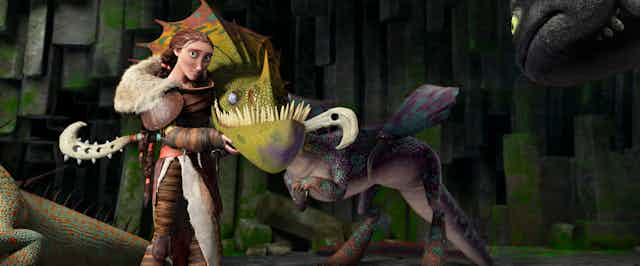The release of DreamWorks’ How to Train Your Dragon 2 has once again brought into relief the fact that animated feature films now regularly attract a host of Hollywood stars and high-profile performers to the medium. The presence of a “star voice” is an expected requirement of contemporary animated cinema.
But what happens to voice pros who have none of that pulling power?
With a cast that includes Academy Award-winning actress Cate Blanchett, alongside Hollywood star Gerard Butler, comedian Jonah Hill and Ugly Betty herself, America Ferrara, How to Train Your Dragon 2 regularly invites audiences to play a game of deciphering and decoding (“that sounds like”, “that could be”) each time one of its animated characters opens their mouth.
The idea of a star voice has undoubtedly come to function as an integral and much-anticipated performance element in both the construction and interpretation of animated acting. The spectators’ immediate familiarity with a star’s potent voice makes said stars as ideal candidates for animated voiceover.
The abundance of star sound across recent animated feature films has been traced back to two particular milestones within animation’s very recent history. Firstly, Robin Williams’ energetic delivery and heavily-improvised vocal performance as the Genie in Walt Disney’s Aladdin (1992), and secondly, the proliferation of celebrity guest voice actors in The Simpsons (1989-).
More than 20 years later, the US animation industry’s seemingly unwavering investment in star voice casting means that animation has a more viable and visible position within a film star’s body of work.
The performances of stars such as Tom Hanks (the Toy Story trilogy 1995, 1999, 2010), Brad Pitt (Megamind 2010), Samuel L. Jackson (The Incredibles 2004), Paul Newman (Cars 2006), Meryl Streep and George Clooney (Fantastic Mr. Fox 2009) has dissolved much of the stigma previously attached to animation voicework.

There is increasing evidence to suggest that the star voice is also helping to challenge the film industry’s history of overlooking voice acting as a discipline.
Johnny Depp’s performance in Rango (2011) renewed the debate as to whether the Academy of Motion Picture Arts and Sciences should introduce its own award for animated voiceover.
In April 2011, the Voiceover Times started an online petition for the Oscars to originate a Best Voiceover Performance category, the objective of which was to “achieve a measure of recognition for voice actors that is on-par to on-camera actors”.
Despite the increased credibility afforded to animated voicework by the vocal presence of the stars, recognisable star sound – and celebrity voice casting in general – have been greeted with resistance.
When combined with the revenue generated by excessive merchandise, tie-ins and the requisite multi-film franchise, voice acting can offer a cost-effective return for a vocal performer who may be “on set” only occasionally.
Depp’s vocal performance in Rango was completed in a tight 20-day window, while Woody Allen recorded all his dialogue for Antz (1998) in less than a week.
The star’s intermittent role within the workflow of animated film production has only furnished the view that voice acting is a highly lucrative endeavour undertaken by stars in-between more demanding live-action roles. Across the specialised voice acting community in America too, star voices have also been accused of clouding the achievements of trained voiceover artists.

The rejection of career voice actors in favour of irresistible star speech – in both cinema and even videogames - has exposed another criticism of star voice casting. That is, that the stars offer nothing more than a celebrity endorsement and that they are hired for their commercial value rather than their suitability or “fit” with the role.
Against the relative anonymity of voice artists, the marquee name of a star can certainly prove to be a valuable asset. Stars both act as a source of leverage to attract returning audiences (and entice new ones) and as a stamp of approval.
But there is, at the same time, the feeling that stars simply have to enter the recording booth and sound like themselves – whereas the non-celebrity works harder to demonstrate their extensive vocal range and versatility. Built into this is the potential for an extremely awkward correspondence between the star image and the animated character.

Popular criticisms of Shark Tale (2004) hinted that a star’s persona can obscure the path that an animated character may have taken had a specialist vocal performer (and non-star) been cast in the role. The primacy afforded by Shark Tale to its star cast of Will Smith, Angelina Jolie, Robert De Niro and Renee Zellweger through typecast performances and even elements of character design staged a problematic meeting of star voice, extra-filmic information and final character realisation.
An altogether more solid, stable future for career voice artists may ultimately be found within the terrain of episodic television animation. Although The Simpsons has been rightly credited with paving the way for stars to throw their voices – essentially through a form of ventriloquism – into animated characters, the series’ core group of talented voice actors remain relatively unknown.
Alongside the rise of professional talent schools, voiceover agencies, and workshops across America, long-form television animation provides the most evidence that there remains a market for skilled voice actors that are not (yet) household names.
But the more celebrities are tempted to lend their voices to animated characters, these non-celebrity vocal performers may come to lose their voice completely.

